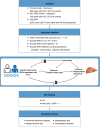Assessing the Causal Effect of Circulating Protein-To-Protein Ratio on the Risk of Morbidity of Hepatocellular Carcinoma
- PMID: 39778021
- PMCID: PMC11705445
- DOI: 10.1002/cam4.70570
Assessing the Causal Effect of Circulating Protein-To-Protein Ratio on the Risk of Morbidity of Hepatocellular Carcinoma
Abstract
Objective: Several observational studies have identified an association between plasma proteins and hepatocellular carcinoma (HCC). This study aimed to explore the potential causal relationship between the circulating protein-to-protein ratio and the morbidity risk of HCC.
Methods: Genetic association data for circulating plasma proteins and 2821 protein-to-protein ratios were sourced from the UKB PPP and Suhre's study. Genetic association data for HCC were sourced from the FinnGen cohort (finngen-R11-HCC) and the IEU OpenGWAS project (ieu-b-4953). Subsequently, a two-sample Mendelian randomization (MR) and drug-targeted MR approach were used to evaluate causality associations. To bolster the robustness of our findings, we conducted a series of sensitivity analyses.
Results: Eight protein-protein pairs were identified as causal factors for HCC in the two independent cohorts. For each standard deviation increase in protein-protein pair expression, susceptibility to HCC fluctuated from 0.4974 (95% confidence interval [CI]: 0.2506-0.9871) for the LAT2/SPRY2 protein pair to 1.9763 (95% CI: 1.3009-3.0026) for the ERBIN/LAT2 protein pair. However, among the significant protein pairs, only one circulating protein, TDRKH (odds ratio: 0.5964, 95% CI: 0.4196-0.8476), was causally associated with HCC.
Conclusion: Using multiple datasets and methods, eight protein-protein pairs were identified as having causal associations with HCC. Protein-protein interactions can provide meaningful findings beyond simple pQTL analysis.
Keywords: Mendelian randomization; circulating proteins; hepatocellular carcinoma; protein‐to‐protein ratio.
© 2025 The Author(s). Cancer Medicine published by John Wiley & Sons Ltd.
Conflict of interest statement
The authors declare no conflicts of interest.
Figures





Similar articles
-
Causality of blood metabolites on hepatocellular carcinoma and cholangiocarcinoma: a metabolome-wide mendelian randomization study.BMC Cancer. 2025 Mar 4;25(1):389. doi: 10.1186/s12885-025-13690-3. BMC Cancer. 2025. PMID: 40038628 Free PMC article.
-
Causal associations between platelet count, alcohol consumption, and the risk of liver hepatocellular carcinoma based on a Mendelian randomization study.Front Endocrinol (Lausanne). 2024 May 22;15:1400573. doi: 10.3389/fendo.2024.1400573. eCollection 2024. Front Endocrinol (Lausanne). 2024. PMID: 38841303 Free PMC article.
-
Enhanced circulating transforming growth factor beta 1 is causally associated with an increased risk of hepatocellular carcinoma: a mendelian randomization meta-analysis.Oncotarget. 2016 Dec 20;7(51):84695-84704. doi: 10.18632/oncotarget.13218. Oncotarget. 2016. PMID: 27835897 Free PMC article.
-
Causal Effect of Immunocytes, Plasma Metabolites, and Hepatocellular Carcinoma: A Bidirectional Two-Sample Mendelian Randomization Study and Mediation Analysis in East Asian Populations.Genes (Basel). 2024 Sep 9;15(9):1183. doi: 10.3390/genes15091183. Genes (Basel). 2024. PMID: 39336774 Free PMC article.
-
Association between rs738409 polymorphism in patatin-like phospholipase domain-containing protein 3 (PNPLA3) gene and hepatocellular carcinoma susceptibility: Evidence from case-control studies.Gene. 2019 Feb 15;685:143-148. doi: 10.1016/j.gene.2018.11.012. Epub 2018 Nov 4. Gene. 2019. PMID: 30403964 Review.
Cited by
-
Genetic evidence for causal effects of inflammatory protein factors on breast cancer.Discov Oncol. 2025 Aug 7;16(1):1490. doi: 10.1007/s12672-025-03370-w. Discov Oncol. 2025. PMID: 40773112 Free PMC article.
References
MeSH terms
Substances
Grants and funding
LinkOut - more resources
Full Text Sources
Medical
Miscellaneous

